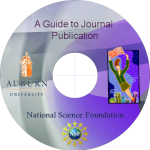

Common Methods for Assessing Journals
1. Citation Analysis and Impact Factor
A high number of citations generally indicates a high level of quality for both individual articles and for journals. Article citations are a good way to assess the merits of a particular author or article. Impact factor is based on the number of times that articles in a journal are cited in the two years following the year of publication. High impact factor or highly cited journals are considered more prestigious and important. See the special section of this CD ROM on Impact Factors.
2. Acceptance/Rejection Rate of the Journal
The acceptance and rejection rates of journals can be a determining factor. Low acceptance rate, high rejection rate journals are considered the best and most prestigious journals. These acceptance and rejection rates can be found in directories of periodicals in certain disciplines. Many journals and societies have web pages that give publication data and style requirements and often include acceptance/rejection rates. The paper copy of the journal occasionally includes this data and will always provide current contact information.
3. Prestige and Reputation of the Journal
The age, prestige and reputation of the association, society, or organization publishing a journal can be a determining factor. Theoretically, the most prestigious scholarly associations such as IEEE publish the best, most important, research in the field and therefore their journals have more prestige and weight than others. There are a handful of scholarly journals that are known by reputation throughout the world, such as Science and Nature.
Looking to see who and what institutions are represented on the editorial board is another way to assess prestige. If the top scholars in your area are associated with a journal, you can take that as a sign of the journal's position within the field.
4. Indexing Services covering the Journal
Whether a journal is indexed in the major indexing/abstracting services in the field is another criterion that can be used to assess a journal.
5. Circulation of the Journal
High readership and circulation are correlated with a journal's quality and/or popularity. Circulation numbers can be found in Ulrich's International Periodicals Directory or the publisher's website.
6. Knowledge of the Field and Journals in the Field
Ask your colleagues, especially senior ones, which journals are the most prestigious for your field. Chances are that they have knowledge of the variety of journals and can give you good advice on which ones are considered the best, the middle and lesser. But make sure you get several opinions as different people have different views on the journals based on their own experiences and allegiances.
